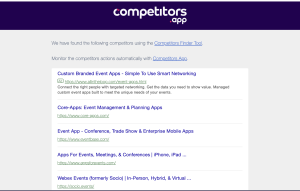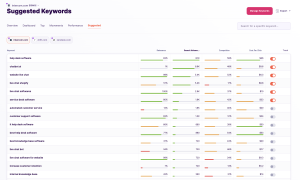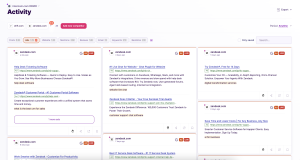Unlock Growth: Your Essential Competitor Finder Guide
In today's fiercely competitive digital landscape, understanding your rivals isn't just an advantage—it's a necessity. A robust competitor finder strategy is the bedrock upon which successful businesses build their growth. Without a clear picture of who you're up against, what they're doing well, and where their weaknesses lie, you're essentially navigating a complex terrain blindfolded. This comprehensive guide will illuminate the path, showing you how to effectively identify, analyze, and learn from your competition to propel your own enterprise forward.
From identifying your closest market adversaries to dissecting their SEO tactics, content strategies, and even their advertising spend, mastering the art of competitor analysis equips you with invaluable insights. It allows you to anticipate market shifts, capitalize on emerging opportunities, and mitigate potential threats before they escalate. By embracing the principles of strategic competitive intelligence, you'll not only survive but thrive, consistently staying one step ahead in the race for market share and customer loyalty.
Table of Contents
- The Indispensable Role of a Competitor Finder in Modern Business
- Identifying Your True Competitors: Beyond the Obvious
- Unearthing SEO Dominance: Backlinks and Keywords
- Beyond SEO: Content, Social, and PPC Insights
- Measuring Performance: Traffic, Clicks, and Referrals
- Essential Tools for the Modern Competitor Finder
- Turning Insights into Action: Strategic Decision Making
- The Continuous Cycle of Competitive Monitoring
The Indispensable Role of a Competitor Finder in Modern Business
In the fast-paced world of business, standing still is akin to moving backward. Every decision, from product development to marketing campaigns, carries significant weight and financial implications. This is precisely why competitor analysis is critical for making informed strategic decisions. It’s not just about knowing who your rivals are; it's about understanding their playbook, anticipating their next move, and leveraging that knowledge to refine your own strategies. A skilled competitor finder isn't just looking for weaknesses; they're identifying strengths that can be adapted, gaps that can be filled, and opportunities that can be seized.
Consider the potential financial impact: a poorly targeted marketing campaign or a product launch that misses the mark can cost a business thousands, if not millions, of dollars. Conversely, a well-executed strategy informed by deep competitor insights can lead to significant revenue growth, increased market share, and a stronger brand presence. For instance, if you're a budding e-commerce store, knowing which products your top competitors are heavily promoting, how they price them, and what kind of ad copy resonates with their audience can save you months of trial and error and significantly improve your return on investment. This proactive approach minimizes risks and maximizes potential returns, directly impacting your bottom line and long-term viability.
Identifying Your True Competitors: Beyond the Obvious
Before you can analyze, you must first identify. This might sound straightforward, but often, businesses only focus on direct competitors – those offering identical products or services. However, a truly effective competitor finder strategy goes deeper. This competition analysis focuses on identifying who those competitors are, including indirect and even aspirational competitors.
Direct competitors are easy to spot: they sell what you sell to the same audience. But what about indirect competitors? These are businesses that solve the same customer problem but with a different solution. For example, if you sell high-end coffee machines, a direct competitor sells similar machines. An indirect competitor might be a premium coffee shop chain, or even a subscription service for pre-made cold brew. Both are vying for the same customer's coffee budget.
Furthermore, you need to learn which sites are your closest competitors not just in terms of products, but also in terms of online visibility. A small blog in your niche that consistently outranks you for key informational keywords, even if they don't sell products, is a competitor for search engine real estate and audience attention. Understanding this broader competitive landscape is crucial for a holistic strategy. It helps you identify emerging threats and potential partners, expanding your strategic horizons beyond the immediate market.
Unearthing SEO Dominance: Backlinks and Keywords
In the digital realm, search engine optimization (SEO) is often the battleground where market share is won or lost. A powerful competitor finder will meticulously dissect the SEO strategies of rivals, particularly focusing on their keyword and backlink profiles. This isn't about copying; it's about understanding what works and identifying opportunities to outmaneuver them.
Decoding Competitor Keyword Strategies
One of the first steps in an SEO competitor analysis is to understand which keywords your rivals are targeting and how well they're performing for them. You can search competitor keywords to plan your next steps. This involves more than just seeing their top-ranking terms. It's about uncovering their long-tail keyword strategies, identifying new keyword opportunities they might be exploiting, and understanding the intent behind the keywords they rank for.
For instance, if you're a software company, your competitor might be ranking for "best CRM for small business" (a high-intent commercial keyword), but also for "how to improve customer retention" (an informational keyword targeting a broader audience earlier in their journey). By analyzing these, you can refine your own keyword strategy, focusing on high-value terms and discovering underserved niches. Many tools allow you to start by typing a keyword into their search bar to see which competitors rank for it, providing a direct pathway to understanding their keyword universe. This data is indispensable for making informed, strategic choices for both SEO and PPC campaigns.
The Power of Backlink Gap Analysis
Backlinks are often considered the "votes" of the internet, signaling authority and trustworthiness to search engines. Analyzing your competitors' backlink profiles is a critical component of any robust competitor finder strategy. You need to check competitor backlinks by keyword to see which authoritative sites are linking to them for specific topics.
More importantly, you want to find out which backlinks do your competitors have that you don't. This is known as a backlink gap analysis. It reveals potential link-building opportunities you might have missed. If a high-authority industry blog links to your competitor's article on "digital marketing trends," it's a strong signal that you should also be creating compelling content on that topic and reaching out to that same blog for a link. By doing so, you can see the exact links that let them outrank you on a specific keyword, and then devise a strategy to acquire similar or even better links. This direct correlation between backlinks and search ranking makes this analysis incredibly valuable for improving your own organic visibility.
Beyond SEO: Content, Social, and PPC Insights
While SEO is crucial, a holistic competitor finder approach extends far beyond. Successful businesses integrate their SEO efforts with robust content marketing, active social media engagement, and strategic paid advertising. Therefore, it's essential to monitor competitors across SEO, content, social, and PPC channels to get a complete picture of their digital footprint.
Analyzing Content and Social Media Footprints
Content is king, and understanding your competitors' content strategy can unlock significant opportunities. What topics are they covering? What formats are they using (blogs, videos, infographics, podcasts)? How frequently do they publish? Are they creating evergreen content or timely news pieces? By analyzing their content, you can identify content gaps in your own strategy, discover topics that resonate with your shared audience, and even spot areas where their content might be weak or outdated, allowing you to create superior alternatives.
Similarly, their social media presence offers a wealth of information. Which platforms are they most active on? What kind of content gets the most engagement? How do they interact with their audience? Are they running any specific campaigns or contests? By observing their social media activity, you can refine your own social strategy, identify trending topics, and learn best practices for community engagement. This insight helps you understand not just what they're saying, but how their audience is reacting, providing valuable cues for your own content and engagement efforts.
Unpacking PPC Strategies and Ad Copy
Paid advertising, particularly Pay-Per-Click (PPC) campaigns, offers a direct window into your competitors' most aggressive and high-value marketing efforts. Tools designed for competitor analysis allow you to type your competitor's domain (competitor.com, for example) into the spyfu search bar to start your way to seeing how their most successful ad copy evolved over time. This is incredibly powerful. You can see:
- Which keywords they are bidding on for PPC.
- Their estimated monthly ad spend.
- The exact ad copy they are using, and which versions perform best.
- Their landing page strategies.
Understanding their PPC strategy helps you identify profitable keywords you might be overlooking, avoid costly mistakes they've already made, and craft more compelling ad copy. If a competitor has been running a specific ad for months, it's a strong indicator that it's performing well. This insight can save you significant advertising budget and accelerate your learning curve in the PPC arena, directly impacting your profitability.
Measuring Performance: Traffic, Clicks, and Referrals
Beyond understanding what your competitors are doing, it's equally important to understand how well their efforts are paying off. A crucial aspect of being an effective competitor finder is the ability to gauge their performance metrics. You need to measure competitors by the clicks they get and what those clicks translate into in terms of traffic and engagement.
Tools can help you monitor your competition and compare their visitor and page view performance to your own. This direct comparison provides a benchmark for your own growth. Are they experiencing a surge in traffic? Is their average page view duration higher than yours? These insights can point to successful content, user experience, or marketing initiatives on their part that you might want to investigate further.
Furthermore, understanding where their traffic comes from is invaluable. You can see traffic by country and a site’s referrals. This means identifying which websites are sending them visitors (e.g., specific industry publications, forums, social media platforms). If a competitor is getting a significant amount of referral traffic from a particular niche forum, it suggests that forum is a valuable community for your target audience, and you should consider engaging there as well. Geographic traffic data can also inform your international marketing strategies, highlighting regions where competitors are strong or where there might be untapped potential for your business.
Essential Tools for the Modern Competitor Finder
Manually gathering and analyzing all this data would be an impossible task. This is where technology steps in. To be an effective competitor finder, you need to automate data collection and analysis with specialized tools. Fortunately, several tools can help streamline this process, making complex competitor analysis accessible and actionable.
When you use our SEO competitor analysis tool to (or any reputable tool), you gain access to a treasure trove of data. These tools typically fall into several categories:
- All-in-One SEO & PPC Platforms: Tools like Semrush, Ahrefs, and SpyFu are powerhouses. They allow you to analyze competitor keywords, backlinks, organic traffic, PPC campaigns, ad copy, and more. For example, as mentioned earlier, with SpyFu, you can type your competitor's domain (competitor.com, for example) into the spyfu search bar to start your way to seeing how their most successful ad copy evolved over time, providing deep insights into their paid strategies.
- Social Listening Tools: Platforms like Brandwatch, Mention, or Hootsuite allow you to track competitor mentions across social media, forums, and news sites. This helps you understand public sentiment, identify PR opportunities, and monitor their social campaigns.
- Content Analysis Tools: While integrated into SEO platforms, dedicated content tools or even manual review can help identify content gaps, popular topics, and content formats.
- Website Traffic Analysis Tools: SimilarWeb and Alexa (though Alexa is being retired) provide estimates of competitor traffic, audience demographics, and referral sources, offering a high-level view of their online presence.
The right combination of these tools to find your competitors can provide a comprehensive, data-driven understanding of the competitive landscape, transforming guesswork into informed strategy. Investing in these tools is not an expense; it's an investment in strategic intelligence that directly impacts your ability to make money and grow your business.
Turning Insights into Action: Strategic Decision Making
Collecting data is only half the battle; the real value of a competitor finder strategy lies in turning those insights into actionable strategies. As emphasized earlier, competitor analysis is critical for making informed strategic decisions that directly impact your business's financial health and market position.
Once you've gathered intelligence, you can begin to formulate targeted responses. For instance, if your analysis provides insights into which websites you're competing against for specific keywords and you notice a competitor is gaining significant traction for a particular set of terms, you can prioritize creating high-quality content or launching targeted PPC campaigns for those very keywords. Conversely, if you watch for domains gaining on your keywords, you can proactively defend your rankings by updating existing content, building new links, or improving user experience.
This strategic application can manifest in various ways:
- Product Development: Identify gaps in competitor offerings or features that users frequently request but competitors lack.
- Pricing Strategy: Understand how competitors price their products/services and position your own accordingly, whether through competitive pricing or value-added differentiation.
- Marketing & Sales: Learn which channels and messages resonate with your shared audience, optimize your ad spend, and refine your sales pitches.
- Content Strategy: Discover successful content formats, identify underserved topics, and create superior content that outranks rivals.
- SEO & PPC Optimization: Leverage competitor keyword and backlink data to improve your organic rankings and paid campaign efficiency.
Every piece of competitive intelligence should lead to a concrete action plan designed to improve your business's performance and profitability. This isn't just about reacting; it's about proactive innovation and strategic positioning.
The Continuous Cycle of Competitive Monitoring
The competitive landscape is not static; it's a constantly evolving ecosystem. New competitors emerge, existing ones innovate, and market trends shift. Therefore, an effective competitor finder strategy is not a one-time project but an ongoing process. You must continuously monitor competitors across SEO, content, social, and other relevant channels.
Setting up automated alerts and regular reporting from your chosen competitor analysis tools is crucial. This allows you to:
- Track New Entrants: Be aware of new businesses entering your market that could pose a threat.
- Monitor Strategic Shifts: Notice changes in competitor pricing, product launches, or marketing messages.
- Identify Emerging Trends: Spot new keywords, content topics, or social media platforms that competitors are leveraging successfully.
- Gauge Campaign Effectiveness: See if your competitors' latest campaigns are gaining traction or falling flat.
By integrating competitive monitoring into your regular business operations, you ensure that your strategic decisions are always based on the most current and relevant information. This continuous feedback loop allows for agile adjustments to your marketing, product, and sales strategies, ensuring your business remains resilient, competitive, and poised for sustained growth in a dynamic market. Neglecting this ongoing vigilance can lead to missed opportunities and vulnerability to unexpected market disruptions.
Conclusion
In conclusion, mastering the art of being an effective competitor finder is no longer optional; it's a fundamental requirement for any business aiming for sustainable success and profitability. We've explored how a comprehensive competitor analysis helps you identify your true rivals, dissect their SEO and PPC strategies, understand their content and social media footprint, and measure their performance metrics. By leveraging specialized tools and adopting a continuous monitoring approach, you transform raw data into actionable intelligence.
The insights gained from this meticulous process empower you to make informed strategic decisions that directly impact your financial well-being and market standing. From refining your product offerings to optimizing your marketing spend and capturing new market share, competitive intelligence provides the clarity needed to navigate the complexities of modern business. Don't leave your success to chance; embrace the power of competitor analysis. Start implementing these strategies today to gain a significant edge in your industry. Share your thoughts in the comments below: What's one key insight you've gained from analyzing your competitors?

Free Competitor Finder - Competitors App

Free Competitor Finder - Competitors App

Free Competitor Finder - Competitors App